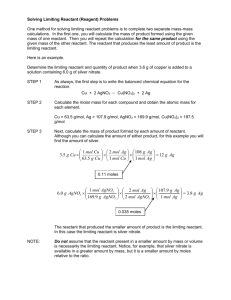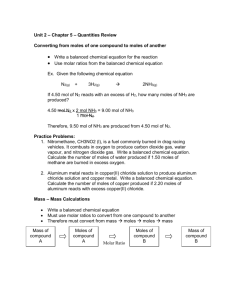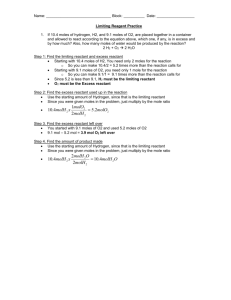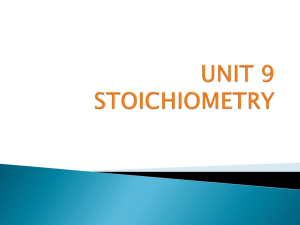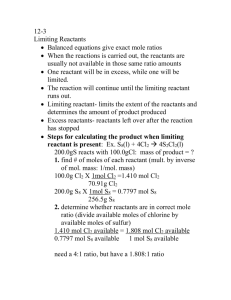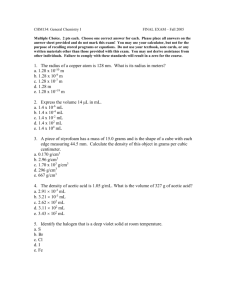11/12
advertisement
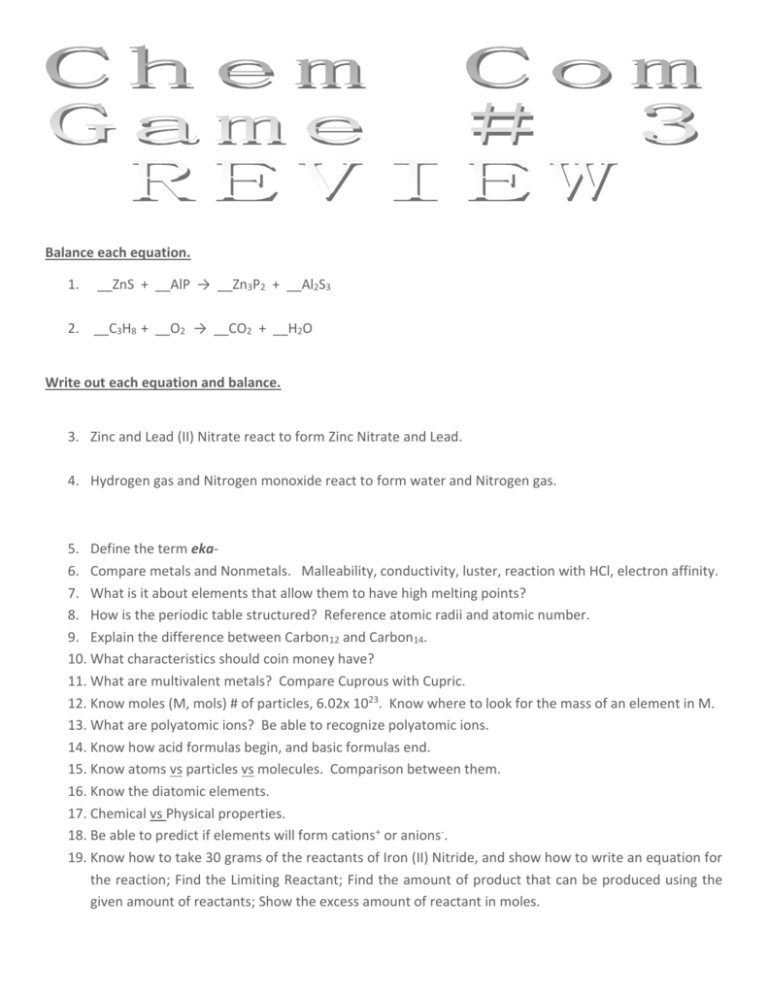
Balance each equation. 1. __ZnS + __AlP → __Zn3P2 + __Al2S3 2. __C3H8 + __O2 → __CO2 + __H2O Write out each equation and balance. 3. Zinc and Lead (II) Nitrate react to form Zinc Nitrate and Lead. 4. Hydrogen gas and Nitrogen monoxide react to form water and Nitrogen gas. 5. Define the term eka6. Compare metals and Nonmetals. Malleability, conductivity, luster, reaction with HCl, electron affinity. 7. What is it about elements that allow them to have high melting points? 8. How is the periodic table structured? Reference atomic radii and atomic number. 9. Explain the difference between Carbon12 and Carbon14. 10. What characteristics should coin money have? 11. What are multivalent metals? Compare Cuprous with Cupric. 12. Know moles (M, mols) # of particles, 6.02x 1023. Know where to look for the mass of an element in M. 13. What are polyatomic ions? Be able to recognize polyatomic ions. 14. Know how acid formulas begin, and basic formulas end. 15. Know atoms vs particles vs molecules. Comparison between them. 16. Know the diatomic elements. 17. Chemical vs Physical properties. 18. Be able to predict if elements will form cations+ or anions-. 19. Know how to take 30 grams of the reactants of Iron (II) Nitride, and show how to write an equation for the reaction; Find the Limiting Reactant; Find the amount of product that can be produced using the given amount of reactants; Show the excess amount of reactant in moles. ANSWERS 1. 2. 3. 4. 5. 3_ZnS + 2_AlP → 1_Zn3P2 + 1_Al2S3 1_C3H8 + 5_O2 → 3_CO2 + 4_H2O Zn + Pb(NO3)2 → Zn(NO3)2 + Pb 2 H2 + 2 NO → 2 H2O + N2 Eka – Standing next in order. Dimitri Mendeleev named “Germanium” this, before it was discovered. He actually named Germanium “ekaSilicon”, as Silicon was before Germanium in the Carbon Family. 6. Metals – Malleable(can be bent), conducts electricity, shiny luster, bubbles in HCl, gives up electrons easily. Nonmetals – Are brittle, nonconductors, dull luster, no reaction to HCl, accepts electrons. 7. Stronger bonds allows for higher melting points. It’s in the structure of these bonds. Screws vs. nails. 8. Atomic Radii increases as one goes down ↓ the Families. Atomic # increase in these directions →↓. 9. Carbon12 – 12 Protons, 12 Neutrons, 12 electrons; Carbon14 -12 Protons, 14 Neutrons, 12 electrons. 10. Coins should have a high luster. They should also be malleable but not brittle. Different colors (metal type), and sizes allow differentiation. Coins should not react with common chemicals so as to dissolve in their presence. 11. Metals that can more than one charge in the ionic state. The suffixes ous and ic determine the difference in ionic charge. 12. Moles, mols, M, = # of particles. 6.02 x1023. Atomic mass of an element is the weight of 1 mole of that element. Eg.. Li = 3 grams/mol, H2 = 2grams/mol, O2 = 32grams/mol, Water (H2O) = 18grams/mol. 13. Ions made up of 2 or more elements. Eg.. NO=, SO4-. 14. Acids form with H+….HCl. Bases end with OH-. NaOH, KOH. 15. Particles – protons, neutrons, electrons etc. Atoms – elements that all have the same characteristics. Molecules – 2 or more elements chemically combined. All molecules react the same. 16. 7 total → H2, N2, O2, F2, I2, Cl2, Br2 17. Chemical properties – When a substance cannot be changed back to its original form. Wood ashes can’t be converted back into wood. EVIDENCE includes bubbles, fizzing, permanent change in color. 18. Cations + - Generally on the left of the Metalloid stair line. Anions - - Generally on the right of the Metalloid stair line. Hydrogen swings both ways. 19. Fe = 56 grams/ mol N2 = 28 grams/mol 1𝑚𝑜𝑙𝐹𝑒 1𝑚𝑜𝑙 𝑁𝑂 30𝑔 𝐹𝑒 ∗ ( 56𝑔 𝐹𝑒 ) = .535 mol Fe 30𝑔 𝑁𝑂 ∗ ( 14𝑔 𝑁𝑂 ) = 2.14 mol N Limiting Reactant is Fe since the number .535 is < 2.14. Equation →→→ 3 Fe + N2 → Fe3N2 Starting Moles .535 + 2.14 → 0 Reacting Moles -3x + -x → x Final Moles 0 1.96 Equation .535 - 3x 2.14 - x Limiting Reactant is Fe. 0.535 mol of Fe is the amount of product made. Excess moles is 1.96 mols of N 2.





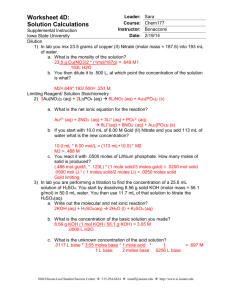
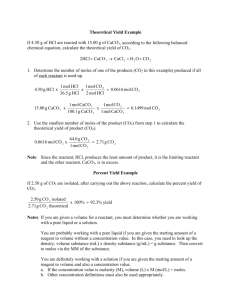

![Kinetics:Reaction Rate[C,T]](http://s3.studylib.net/store/data/009563942_1-e590bbd349efbd5a36ce699f7c552bf3-300x300.png)
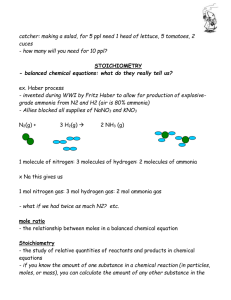
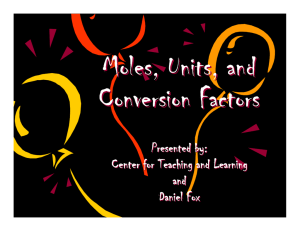
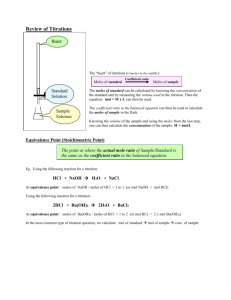
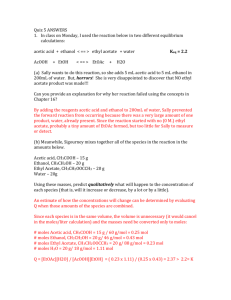
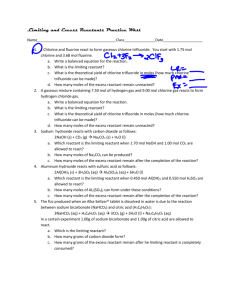
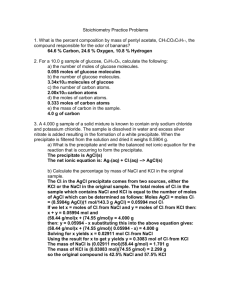
![[OH-] = sqrt(Ksp/[Mg2+]) = sqrt((1.8 x 10-11)/(5 x 10-3))](http://s3.studylib.net/store/data/008916379_1-09cad59ef42f1f52b1caf2585ae9902b-300x300.png)
